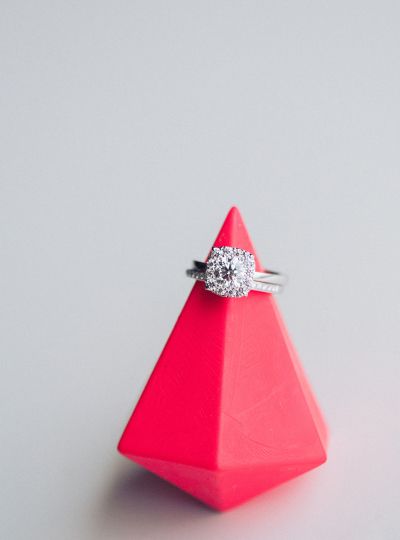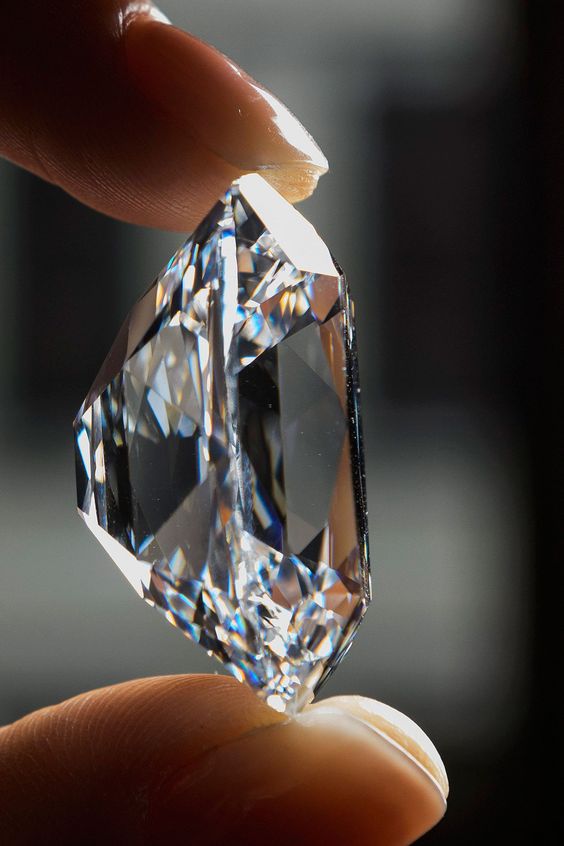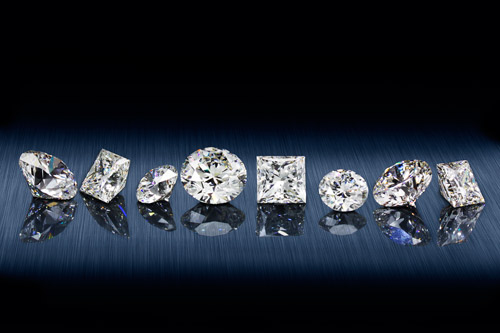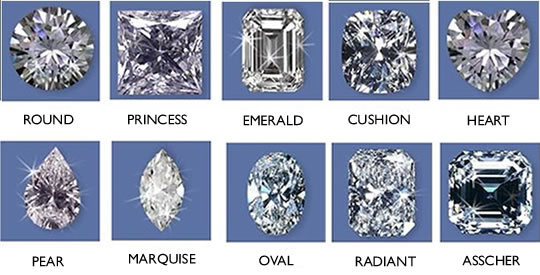To help make this distinction a little easier to understand, us here at PJD have put together a little guide to diamond cut, as well as a bit on how to use this information to find the perfect diamond for any jewelry situation.
[*Ed. Note: For more information on the 4 C’s in general, please refer to our previous article “The 4 C’s of Finding the Perfect Diamond” ~~Heather*]
Diamond Cut Definition #1: Shape
The most quickly recognizable aspect of any diamond, this meaning of diamond cut refers to the actual physical shape of the stone. This includes shapes that you may have heard of such as round (brilliant), princess, or emerald, as well of cuts that perhaps less well-known, like asscher, trilliant, and marquise.
Each cut has various advantage and disadvantages depending on the type of jewelry the stone adorns, the stone setting used (prong, halo, channel, etc), and the various fashion preferences of the wearers themselves.
(Very) Basic Explanation of Popular Diamond Shapes
- Asscher Cut: Resembling the emerald cut diamond, asscher shaped stones feature large, clear facets, steep crown angles, and high diamond table.
- Cushion Cut: Sometimes referred to as “pillow-cut”, cushion cut diamonds are renowned for their streamlined rounded corners and unique diamond fire.
- Emerald Cut: Emerald cut diamonds are defined by their somewhat rectangular shape, step cuts, and “hall-of-mirrors” effect.
- Heart Cut: This modified brilliant-cut diamond looks just like it sounds, heart-shaped.
- Marquise Cut: Marquise cut diamonds are somewhat football-shaped (meant resemble the mouth of the Marquise of Pompadour), with a large crown surface.
- Oval Cut: Oval cut stones possess a similar sparkle and brilliance to that of a round cut stone, yet offer a more distinctive circle-like cut.
- Pear Cut: Resembling a mixture between a round and a marquise cut diamond, pear cut diamonds feature one rounded end with the other coming to a point (like a water droplet).
- Princess Cut: Princess cut diamonds are some of the most popular in the world due to their square top, pyramid shape, versatility, and relatively lower cost.
- Round (Brilliant) Cut: The circle-shaped round diamond is unmatched in the realm of diamonds for its unsurpassed level of sparkle, luminosity, and adaptability.
- Trilliant Cut: Sometimes with curved or uncurved sides, trilliant cut stones have a distinctive triangular shape to them.
Diamond Cut Definition #2: Brilliance and Sparkle
One of the most difficult to analyze, yet crucial attribute of a diamond, cut has a large influence on the brilliance and fire that a diamond will radiate.
Unlike the other 4 C’s of diamonds (color, clarity, and carat weight), the cut of a diamond is entirely the result of human influence, and is closely related to the technical skill of the jewelry cutter who is handling the shaping of the stone.
Also, unlike other diamond criteria, cut has no unified assessment scale. Generally, cut is graded on a scale ranging from “excellent” to “poor”, and according to the Gemological Institute of America (GIA) cut should be measured by an evaluation of how well a diamond interacts with light.
The GIA evaluation for cut is broken up into three criteria:
- Brilliance: the white light reflected from the stone.
- Fire: the amount of refraction of the colors of the rainbow.
- Scintillation: the absolute sparkle produced by the diamond.
These factors are determined by the angle at which the light reflects through the diamond, which is highly influenced by the symmetry of a diamond’s design, the polish of the stone, as well as the proportions, sizes, and angle of the diamond’s facets.
How to Find a Diamond of Superior Shape and Brilliance:
No matter which definition of diamond cut that is more important to you, the most important part of diamond shopping is finding a retailer that know, trust, and who understands your specific needs, concerns, and desires.
Today, most independent fine jewelry retailers specially train their staff to be able to answer any questions and quell any diamond concerns. Often diamond engagement rings, like the ones offered by designers like Hearts on Fire, A. Jaffe, etc, aren’t sold with a center diamond, so finding a helpful salesperson is critical to completing you engagement ring purchase.
In addition to this irreplaceable level of expertise, these retailers often list their available diamonds on their store website, allowing for you to get some sort of an idea of what diamond you might want.
Now It’s Your Turn!
What are some of your tips for finding the perfect diamond? Comment, or hit us up on our Twitter, Instagram, or Facebook!


